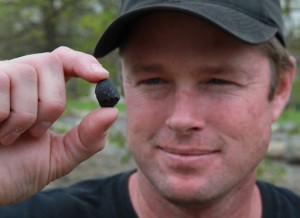

Robert Ward displays one of his finds, a 10 gram carbonaceous chondrite in Lotus, CA (Credits: AP/Rich Pedroncelli).
On the morning of April 22, a fireball the size of a minivan exploded over California and Nevada with the energy of 4 kilotons of TNT. In the days since, meteorite hunters have combed the Sierra Nevada mountains for the remains – and many have struck gold.
According to a Los Angeles Times report, amateur collectors are selling their finds for as much as $1,000 per gram due to the rare nature of the carbonaceous chondrite, a type of meteorite that is thought by many to hold the key to the evolution of life. “We want to learn about this asteroid,” said Peter Jenniskens, a scientist at the Carl Sagan Center at the SETI (Search for Extraterrestrial Intelligence) Institute and the NASA Lunar Science Institute. “This is scientific gold.”
Professional collectors travelled far and wide to join in the hunt. The first reported find came on April 24 from Robert Ward. After a 16 hour drive to Lotus, California, he quickly found two 10 gram rocks and recognized them as carbonaceous chondrite. “I was trembling,” Ward said. “It’s the rarest of the rare. It’s older than the sun. It holds the building blocks of life.”
Once report of Ward’s find got out, everyone joined in the game. A local woman in Rescue, California found a 17 gram stone while walking her dog. She showed it to a group of nearby geologists on the hunt with a metal detector. “I opened my hand and they all let out a collective gasp,” she said, before telling her to get it into a bank vault. A firefighter stopped by on his way to work, found a 2 gram rock and immediately sold it for $2,000.
The rocks are dark, delicate, and look out of place. They are likely strewn over an area more than 16 km in length. Scientists are hoping the rocks will be found as quickly as possible, since rain will likely cause them to degrade and will wash away minerals.
The meteorite that caused all the commotion was not on the list of near Earth objects tracked by NASA, highlighting the gaps in current monitoring programs. “There are millions of objects of that size that we don’t know about,” said Don Yeomans of NASA’s Near-Earth Object Program Office at the Jet Propulsion Laboratory. “They’re too small to image unless they’re right up on top of you.”
Watch more on Ward’s find in CNN’s report below:

















































































































![A trajectory analysis that used a computational fluid dynamics approach to determine the likely position and velocity histories of the foam (Credits: NASA Ref [1] p61).](https://www.spacesafetymagazine.com/wp-content/uploads/2014/05/fluid-dynamics-trajectory-analysis-50x50.jpg)



Leave a Reply